-
New materials to make buildings better, safer
A new type of construction material, called cross-laminated timber, is currently approved for buildings with up to six stories. Designers would like to use it in taller buildings because it is environmentally sustainable and can speed the construction process. To use it for those taller buildings, the industry needs to understand how the timber would perform during a fire. NIST experiments are measuring the material’s structural performance and the amount of energy the timber contributes to the fire.
-
-
Drones help in better understanding of wildfires
U.S. Geological Survey scientists and partners are taking technology to the next level, using unmanned aircraft systems (UAS) to acquire both fire intensity and emissions data during prescribed burns. This effort combines expertise from multiple USGS partners that could reduce the harmful effects of smoke impacts from use of prescribed burns. Lessening the risk to property and lives during wildfires is a primary purpose of prescribed burns.
-
-
New era of western wildfire requires new ways of protecting people, ecosystems
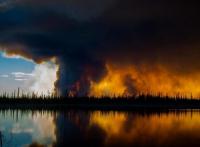
Current wildfire policy cannot adequately protect people, homes, and ecosystems from the longer, hotter fire seasons climate change is causing. Efforts to extinguish every blaze and reduce the buildup of dead wood and forest undergrowth are becoming increasingly inadequate on their own. Instead, experts urge policymakers and communities to embrace policy reform that will promote adaptation to increasing wildfire and warming.
-
-
Humans have dramatically increased extent, duration of U.S. wildfire season
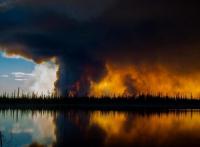
The United States has experienced some of its largest wildfires on record over the past decade, especially in the western half of the country. The duration and intensity of future wildfire seasons is a point of national concern given the potentially severe impact on agriculture, ecosystems, recreation, and other economic sectors, as well as the high cost of extinguishing blazes. The annual cost of fighting wildfires in the United States has exceeded $2 billion in recent years. Humans have dramatically increased the spatial and seasonal extent of wildfires across the United States in recent decades and ignited more than 840,000 blazes in the spring, fall and winter seasons over a 21-year period, according to a new study.
-
-
Extreme fires will increasingly be part of our global landscape
Wildfire burned more than 10 million acres in the United States in 2015, and cost over $2 billion to suppress. There were 23 million landscape fires around the world between 2002 and 2013, and researchers define 478 of them as extreme wildfire events. Increasingly dangerous fire weather is forecast as the global footprint of extreme fires expands.
-
-
Devastating wildfires in Eastern forests likely to be repeated
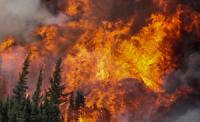
The intense wildfires that swept through the Smoky Mountains in Tennessee late last month were a tragic melding of the past and the future. The fast-moving, wind-whipped blazes that burned more than 150,000 acres, killed fourteen people and damaged 2,400 structures in Gatlinburg and Sevier County may be a portent of things to come.
-
-
Thermal sensor provides warning for firefighter safety
The conditions inside a burning building are perilous and can change rapidly. For firefighters searching for people trapped within a burning building, these risks can be exacerbated in a matter of seconds as exposure to high temperature may cause their personal protective equipment (PPE) to fail. This is particularly true in the presence of infrared radiation, which can rapidly increase the temperature of a firefighter’s environment without warning. DHS S&T is now working with partners to develop the Burn Saver Thermal Sensor, a battery-powered device that will be carried by firefighters and detects thermal changes in their operating environments.
-
-
The origins of Tennessee’s recent wildfires
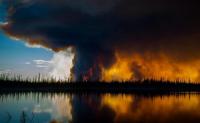
Wildfires raged recently through the foothills of Tennessee’s Great Smoky Mountains, fueled by severe drought and high winds in the eastern part of the state. The fires damaged or destroyed more than 1,400 structures, including homes, chapels, and resort cabins. Fourteen people were killed, and nearly 150 others were injured. Last week, two juveniles were taken into custody and charged with aggravated arson in connection with the deadly wildfires – but sources such as Climate Central suggested that rising temperatures may have played a role in the fires. Does climate change play a role in determining the frequency and intensity of wildfires?
-
-
Firefighters to have bushfire predictions at the fingertips
Researchers at the University of Western Australia are developing a new touchscreen device that can be mounted in a fire truck to help firefighters predict where and when a bushfire will spread. The researchers are modifying bushfire simulation software Australis into a high-end tablet to provide accurate predictions of fire behavior more rapidly than current methods.
-
-
Climate change has doubled Western U.S. forest fire area
Human-induced climate change has doubled the area affected by forest fires in the U.S. West over the last thirty years. Scientists say that since 1984, heightened temperatures and resulting aridity have caused fires to spread across an additional 16,000 square miles than they otherwise would have — an area larger than the states of Massachusetts and Connecticut combined. The scientists warn that further warming will increase fire exponentially in coming decades.
-
-
Public safety consolidation works well for some communities, but not for others
In the first comprehensive work of its kind, a Michigan State University criminologist has completed a study on the implementation and outcomes of public safety consolidation — the merging of a city’s police and fire departments. The study finds that while public safety consolidation can work well for some communities, it is not the best solution for others.
-
-
Impact of demographic development on fires in ecosystems as strong as that of climate change
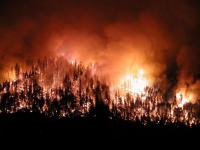
Every year, about 350 million hectares of land are devastated by fires worldwide. This corresponds to about the size of India. To estimate the resulting damage to human health and economy, precise prognosis of the future development of fires is of crucial importance. Previous studies often considered climate change to be the most important factor. Now, a group of scientists has found that population development has the same impact at least.
-
-
Learning to live with wildfires: how communities can become “fire-adapted”
In recent years wildfire seasons in the western United States have become so intense that many of us who make our home in dry, fire-prone areas are grappling with how to live with fire. We know that fuel reduction in dry forests can mitigate the effects of wildfires. After decades of fire exclusion, dense and dry forests with heavy accumulations of fuel and understory vegetation often need to be treated with a combination of thinning and prescribed burning. Native peoples, less than 150 years ago, proactively burned the landscapes we currently inhabit – for personal safety, food production, and enhanced forage for deer and elk. In some places, people still maintain and use traditional fire knowledge. As we too learn to be more fire-adapted, we need to embrace fire not only as an ongoing problem but an essential part of the solution.
-
-
Exploring the unique relationship between fire and mankind
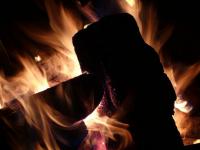
Fire has been an important part of the Earth System for over 350 million years, but humans are the only animals to have used and controlled fire. The complex interrelationships between fire and mankind transcend international borders and disciplinary boundaries. The specter of climate change highlights the need to improve our understanding of these relationships across space and time.
-
-
Seismic networks can serve as the backbone for 21st century firefighting
The same twenty-first century communications network used for real-time seismic monitoring in Nevada and parts of California can provide high-quality images to help first responders catch fires before they grow costly and dangerous. Experts say that seismic networks in place to provide earthquake early warning, if designed to sustain multi-hazard monitoring, can provide a robust data backbone for fire cameras that pan, tilt and zoom as they monitor wildfires and other extreme weather events like remote floods.
-
- All
- Regional
- Water
- Biometrics
- Borders/Immig
- Business
- Cybersecurity
- Detection
- Disasters
- Government
- Infrastructure
- International
- Public health
- Public Safety
- Communication interoperabillity
- Emergency services
- Emergency medical services
- Fire
- First response
- IEDs
- Law Enforcement
- Law Enforcement Technology
- Military technology
- Nonlethal weapons
- Nuclear weapons
- Personal protection equipment
- Police
- Notification /alert systems
- Situational awareness
- Weapons systems
- Sci-Tech
- Sector Reports
- Surveillance
- Transportation
Advertising & Marketing: advertise@newswirepubs.com
Editorial: editor@newswirepubs.com
General: info@newswirepubs.com
2010-2011 © News Wire Publications, LLC News Wire Publications, LLC
220 Old Country Road | Suite 200 | Mineola | New York | 11501
Permissions and Policies
Editorial: editor@newswirepubs.com
General: info@newswirepubs.com
2010-2011 © News Wire Publications, LLC News Wire Publications, LLC
220 Old Country Road | Suite 200 | Mineola | New York | 11501
Permissions and Policies
